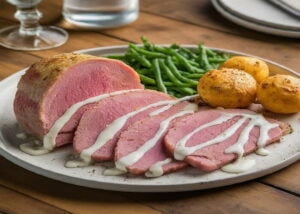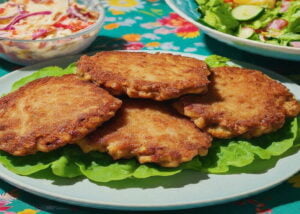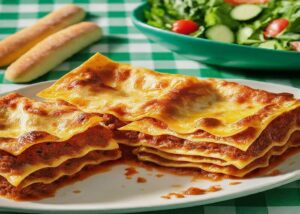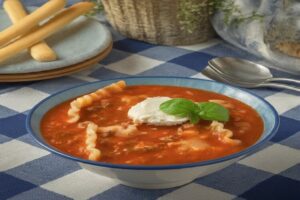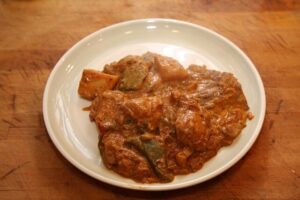Beef, a staple in many cuisines worldwide, is a versatile and flavourful meat enjoyed by millions.
But what exactly is beef?
In its simplest form, beef refers to the meat derived from cattle.
This red meat is prized for its rich taste and nutritional value.
When it comes to types of beef, there are various classifications based on the age and sex of the cattle.
For example, ‘beef’ typically refers to meat from adult cattle, while ‘veal’ comes from young calves.
Additionally, the quality of beef can be determined by factors such as marbling (intramuscular fat) and tenderness.
Ever wondered what beef is made of? Beef primarily consists of muscle tissue along with connective tissue and fat. This combination gives beef its distinctive texture and flavour profile.
Different cuts of beef offer varying levels of tenderness and taste, making them suitable for a wide range of culinary applications.
From succulent ribeye steaks to hearty brisket roasts, understanding the different cuts of beef can elevate your cooking game.
Whether you prefer a tender fillet or a flavourful sirloin, exploring the world of beef cuts opens up a realm of culinary possibilities.
Stay tuned as we delve deeper into the fascinating world of beef, uncovering its nuances and exploring creative ways to make the most out of this beloved meat in your kitchen.
Exploring the Culinary World: What is Beef and How to Make the Most of It
By definition, beef is a type of meat that comes from cattle.
Beef can refer to the flesh of any age or gender of bovine, but it’s commonly used to describe the meat from adult cows.
This type of meat is commonly consumed around the world in various forms such as steaks, roasts, patties, and minced/ground beef.
The term “Beef” is used to collectively refer to a variety of cuts from many different body parts of cattle.
Thus, beef is a general term that includes different cuts like steaks, roasts, and minced/ground beef.
Calling meat “Beef” is an easier way to refer to an entire animal than having to specify each individual cut.
Beef is one of the most popular meats consumed worldwide, known for its rich flavour and versatility in cooking. Derived from cattle, beef comes in various cuts that offer different textures and tastes, making it a staple ingredient in many cuisines.
To make the most of beef in your cooking, it’s essential to understand the different cuts available.
From tenderloin to brisket, each cut has its unique characteristics and best cooking methods.
For example, tenderloin is prized for its tenderness and is perfect for quick-cooking methods like grilling or pan-searing.
On the other hand, brisket benefits from slow cooking techniques such as braising or smoking to achieve a melt-in-your-mouth texture.
When preparing beef dishes, marinating can enhance flavours and tenderise tougher cuts.
Simple marinades with ingredients like soy sauce, garlic, and herbs can elevate the taste of your beef dishes significantly.
Experimenting with spices and seasonings can also help you make the most of beef.
From classic pairings like rosemary and thyme to bold flavours like cumin and paprika, there are endless possibilities to create delicious beef dishes that suit your taste preferences.
Whether you’re grilling steaks for a special occasion or simmering a hearty beef stew for a comforting meal, understanding the basics of beef cuts and cooking techniques can help you unlock the full potential of this versatile meat in your culinary creations.
The Nutritional Value and Health Benefits of Including Beef in Your Diet
Beef is a nutrient-rich food that offers various health benefits when included in your diet.
It is an excellent source of high-quality protein, essential vitamins, and minerals that are vital for overall well-being.
Protein is a key component found in beef, making it an ideal food choice for muscle growth and repair.
The protein content in beef helps in maintaining muscle mass, supporting weight management goals, and providing sustained energy throughout the day.
In addition to protein, beef is rich in essential vitamins such as B-complex vitamins (B12, B6, niacin) which play a crucial role in metabolism, energy production, and red blood cell formation.
These vitamins are essential for maintaining healthy nerve function and supporting cognitive health.
Beef also contains important minerals like iron, zinc, and selenium.
Iron is necessary for the production of red blood cells and oxygen transport throughout the body. Zinc supports immune function and wound healing while selenium acts as an antioxidant that helps protect cells from damage.
Including beef in your diet can provide a range of nutrients that contribute to overall health and well-being. However, it’s important to consume lean cuts of beef to minimise saturated fat intake. Pairing beef with a variety of fruits, vegetables, whole grains can help create a balanced meal that supports optimal nutrition.
In conclusion, incorporating beef into your diet can be a valuable way to obtain essential nutrients like protein, vitamins (B-complex), and minerals (iron, zinc).
As with any food choice, moderation and balance are key to enjoying the nutritional benefits while maintaining a healthy lifestyle.
Australian and NZ Beef Cuts vs American
When comparing NZ and Australian beef cuts to American beef cuts, it’s important to understand the differences in the primal cuts of the carcass.
| Australian and New Zealand Beef Cuts |
|---|
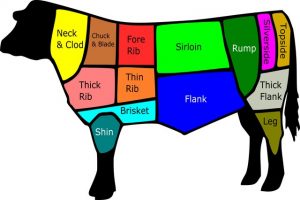 Each of these primal cuts contains various sub-cuts that are popular for different cooking methods. |
| US Beef Cuts |
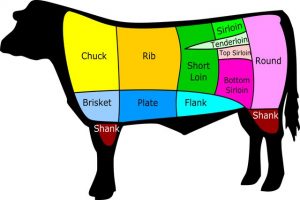 However, there may be slight variations in how these primal cuts are butchered and named compared to Australian beef. |
Understanding the differences between Australian and American beef cuts can help both consumers and chefs choose the right cut for their desired dish.
There’s a good deal of overlap between Australia, New Zealand, and the United States when it comes to beef cuts, but there are also some key differences:
Similarities:
- Brisket, Cheeks, and Tallow:
- These cuts are generally similar across all three regions.
Brisket comes from the breast, cheeks from the face, and tallow is rendered fat.
Differences:
- Chuck:
- While both regions get chuck from the shoulder and neck, specific sub-cuts within the chuck might have different names.
- Flank and Skirt:
- This is where things get interesting.
Both Australia and New Zealand tend to further divide the flank into:- Thick Flank:
Similar to the US flank steak. - Thin Flank:
Resembles a US skirt steak. In the US, the flank is typically just separated into flank steak (thicker) and skirt steak (thinner).
- Thick Flank:
- Sirloin:
- This is a big area of confusion:
Australian/NZ Sirloin: Often refers to cuts from the top sirloin, similar to a US sirloin steak. - Porterhouse:
- Here’s the twist. What Australians and New Zealanders call a porterhouse is closer to a US T-bone steak. It has a portion of the tenderloin and sirloin separated by a T-shaped bone.
- US Sirloin:
- This can sometimes encompass what Aus/NZ call the porterhouse cut, depending on the specific location within the sirloin.
Whether you’re looking for a tender cut for grilling or a flavourful cut for slow cooking, knowing the characteristics of each beef cut is essential.
Stay tuned as we delve deeper into the specific characteristics and uses of Australian and American beef cuts
Dive into Deliciousness: A Look at Popular Beef Cuts and Their Culinary Uses
Beef chuck, brisket, cheek, flank, sirloin steak, skirt, tallow and Wagyu are all popular cuts of beef with unique culinary uses and flavours that can enhance a variety of dishes.
When it comes to beef cuts, each part of the animal offers a unique taste and texture that can elevate your culinary creations. Let’s dive into the delicious world of popular beef cuts and explore their culinary uses.
- Beef Chuck;
The beef chuck comes from the shoulder area of the cow and is known for its rich, beefy flavor.Beef Chuck cuts are often used to make roasts and steaks, as they contain connective tissues which get tender during slow cooking.
This cut is best marinated or braised slowly over a low heat on the stovetop or in an oven so that it becomes tender and juicy.
These cuts are most often cooked using moderate-heat methods such as braising or stewing and are great for making pot roasts, stews, and casseroles.
- Beef Short Ribs;
Short ribs are cut from the rib and plate primals, just behind the front shoulder area of the cow.
They are a delicious yet hearty cut taken off the bone connected to them.
Once you remove these bones though, you’re left with succulent pieces perfect for slow cooking into an intensely flavourful meal.Their high fat content makes them well-suited for braising, slow roasting, or frying.
Short ribs have a robust and beefy flavour and can be used as stand-alone cuts or in large pieces for roasts. - Oyster Blade Steak;
Known as butlers’ steak (U.K.), feather blade steak (U.K.) or Flat Iron steak (U.S.) is a cut of steak cut with the grain from the chuck, or shoulder of the animal.
This steak is becoming increasingly popular and has been referred to as one of the “new” super-tender steaks.It is a lean cut that contains excellent marbling, giving it a juicy flavour and tender texture compared to most other lean beef options.
Flat Iron steaks are best served cooked medium-rare to medium, with short cooking times at high heat recommended. - Sirloin Steaks;
Sirloin steaks are cuts of steak taken from the back end of the cow, near its hip.
They are generally more leaner than rib-eye, offering more flavour and a more tender texture.Sirloin steaks can be cooked a variety of ways, including barbecue grilling, searing, roasting or under the gril/broiling.
Try using slightly gentler cooking methods so you don’t overcook them, pan-frying or baking rather than charring over an open fire for instance, but still using fast methods so those hearty flavours remain intact!They are best served medium-rare to medium, with short cooking times at high heat recommended.
- Sirloin Tip Roast;
Sirloin tip roast comes from the loin region – located in between chuck rib eye roles – so you know you are getting quality flavour no matter what!It works great when grilled over medium heat or roasted until just moderately rare since overcooking will cause this cut to become tough and unappealing.
If you’re looking for a flavourful but leaner alternative without sacrificing any flavours, try sirloin tip roast next time! - Tenderloin Steak;
Tenderloin steak cuts come from either side of spine near the back end on both sides near the rib area in small prime cuts.
Tenderloin steak is one of your more expensive cuts but also one of your tenderest meats due to its low amount of connective tissue compared to other beef cuts;
It has a mild flavour and can be seasoned with a variety of spices and herbs to make it more flavourful.Commonly cooked by grilling or roasting, but it’s also ideal for quickly searing on high heat methods such as those restaurant-style charred outsides with pink interiors so beloved by foodies everywhere!
- Ribeye Steak;
Ribeye steak comes from the rib section of the cow just behind the chuck roast and it makes the most decadent steaks.
The combination of its high fat content and marbling gives it intense flavour.A ribeye should be cooked using a hot cooking method such as grilling or pan-searing to bring out its complex flavours without drying out and toughening up too much during cooking.
- Bottom Round Roast;
This is also known as Eye round roast and is called beef silverside in the UK, Ireland, Australia and New Zealand.
The bottom round roast comes from the rump area of the cow, making it a great economical cut of beef.It is an economical alternative when it comes to roasts as it’s typically one of the most inexpensive cuts to buy.
It offers leaner results than some other roasts, however, its mild flavour tends to lack in comparison with those cuts.It has a mild beefy flavour and is best cooked low and slow to make sure it stays tender and juicy.
To get the best taste out of this cut, make sure to use your favourite seasonings before cooking!Bottom round roast is perfect for roasting in the oven or slow cooking in a crockpot.
- Brisket;
Beef brisket is a flavourful cut that comes from the forequarter or chest area of the cow.
It has a good amount of marbling which makes it ideal for smoking. braising or slow-roasting in a low oven temperature or stovetop.When cooked right you can expect briskets hearty flavour reminiscent of fine steakhouse fare!
Beef brisket is a staple in barbecue culture and can be enjoyed sliced thinly or shredded in sandwiches. - Beef Cheek:
Beef cheek is a lesser-known cut that offers incredible tenderness and flavour when cooked properly.It is often braised or slow-cooked to bring out its rich, gelatinous texture.
Beef cheek is popular in dishes like tacos, stews, and casseroles. - Rump Roast;
Rump roast has recently become quite popular among home cooks given its affordability and robust flavour profile
It is perfect for long slow cooking that heightens its natural juices as well as creates incredible mouthfeel during each bite!Rump roast also transitions between dry rubs/seasonings nicely while keeping moisture content at bay.
If you’re looking for something juicy yet subtle go with rump!
These popular beef cuts offer an array of flavours and textures that can take your culinary skills to new heights! Experiment with different cuts to discover your favourite ways to enjoy these delicious meats.
Cooking Method Basics for Beef
When it comes to cooking beef, there are various methods to choose from depending on your preferences and the dish you want to prepare.
Let’s explore some popular cooking methods for beef:
- Airfrying:
Air frying is a healthier alternative to deep frying that uses hot air circulation to cook food.
It results in crispy and delicious beef dishes with less oil. - Barbecuing:
Barbecuing is a beloved tradition, especially during summer months.
Grilling beef over an open flame or hot coals imparts a smoky flavour that enhances the taste of the meat. - Casserole:
Casseroles are slow-cooked dishes where beef is simmered with vegetables and seasonings in a covered pot or baking dish.
This method allows the flavours to meld together for a comforting meal. - Chargrilling:
Chargrilling involves cooking beef over high heat on a grill or griddle pan, creating distinctive grill marks and adding a charred taste to the meat. - Oven Grill/Broiling:
Broiling or Oven Grilling is similar to barbecue grilling but involves cooking beef under direct heat in an oven.
It’s a quick method that results in juicy steaks with a caramelised crust. - Pan Frying:
Pan frying is ideal for quickly searing cuts of beef in a hot pan with oil, creating crispy edges while keeping the inside tender and juicy. - Poaching:
Poaching involves gently simmering beef in liquid such as broth or wine until it’s cooked through and tender, making it suitable for delicate preparations. - Roasting:
Roasting large cuts of beef in an oven at high temperatures produces succulent meat with crispy edges, perfect for Sunday roasts or special occasions. - Smoking:
Smoking infuses beef with rich, smoky flavours by slow-cooking it over wood chips or charcoal in a smoker, resulting in tender and flavourful meat. - Stewing:
Stewing involves simmering beef slowly with vegetables and herbs in liquid until it becomes tender and develops complex flavours, perfect for hearty stews and casseroles. - Slow-Cooking:
Slow-cooking allows tough cuts of beef to become tender by cooking them at low temperatures over an extended period, resulting in melt-in-your-mouth dishes like pulled beef or braised meats. - Stir Fry:
Stir-frying quickly cooks thinly sliced strips of marinated beef with vegetables over high heat, retaining their natural juices and nutrients while creating flavourful dishes like stir-fry noodles or rice bowls.
Each cooking method brings out different textures and flavours from the same cut of meat, giving you plenty of options when preparing delicious Australian-style beef dishes!
From Farm to Table: Understanding the Journey of Beef Production
Beef production is a complex process that involves several stages from farm to table.
Sustainable beef production has become a growing concern, leading to the adoption of various farming methods to ensure both environmental and animal welfare standards are met.
Organic farming methods for cattle focus on avoiding synthetic chemicals and pesticides, promoting the use of natural resources and sustainable practices.
This approach aims to produce high-quality beef while minimising harm to the environment.
In contrast, conventional farming methods for cattle in Australia often involve large-scale operations with a focus on efficiency and productivity.
These farms may use technology and modern practices to maximise output while adhering to industry regulations.
Similarly, conventional farming methods for cattle in New Zealand may vary but generally prioritise grass-fed systems due to the country’s favourable climate for pasture-based agriculture.
This approach emphasises animal health and natural grazing habits, resulting in leaner beef products with distinct flavour profiles.
Understanding the journey of beef production from farm to table sheds light on the diverse practices employed by farmers worldwide.
Whether through organic or conventional methods, each stage plays a crucial role in delivering high-quality beef products that meet consumer demand while upholding sustainability standards.
The Cultural Significance of Beef Around the World: A Global Perspective
Beef has a rich cultural significance around the world, with each region showcasing its unique take on this beloved meat.
From the succulent steaks of Argentina to the aromatic curries of India, beef dishes play a central role in various cuisines globally.
In Argentina, beef holds a special place in the hearts of locals, with traditional asados (barbecues) being a common social gathering where families and friends bond over grilled meats.
The famous Argentine dish, Bife de Chorizo, is a thick sirloin steak seasoned simply with salt and cooked to perfection on open flames.
Moving to Japan, we encounter Wagyu beef, renowned for its marbled texture and exquisite taste.
This prized beef is often enjoyed in dishes like Sukiyaki and Shabu-Shabu, where thinly sliced pieces are cooked at the table in a hot pot.
In India, beef holds cultural significance for certain communities where it features prominently in dishes such as Beef Vindaloo from Goa or Kerala’s spicy Beef Fry.
These recipes reflect the diverse culinary heritage of the country and showcase how beef is prepared differently across regions.
Exploring further into global cuisine, we find iconic dishes like American BBQ brisket, French Beef Bourguignon, and British Beef Wellington.
All these dishes highlight the versatility of beef in creating hearty and satisfying meals that resonate with people worldwide.
The cultural importance of beef consumption extends beyond just food; it often symbolizes tradition, celebration, and community gatherings.
Whether it’s a festive occasion or a simple family dinner, beef dishes have woven themselves into the fabric of various cultures worldwide.
Recipe Ideas for Beef
Beef is incredibly versatile and can be cooked in a range of ways to suit any recipe.
Whether you’re looking for the perfect dinner party dish or a quick and easy family meal, there are plenty of options
See our recipes here!
FAQ
How Long Does Beef Last In The Fridge?
Raw beef can last up to 3-5 days if properly stored in the fridge.
It should be fresh, then wrapped securely and placed on the lowest shelf, away from any other food items, to avoid cross contamination.
Be sure to smell and inspect it before cooking or eating.
How Long Can You Keep Raw Beef in the Freezer?
Raw beef can last up to 6 months in your freezer if stored properly.
Be sure to wrap it tightly and store it at 0°F (-18°C) or lower.
Ground beef can last up to 3 months before freezing, while steaks can last up to 12 months.
Is Brown Beef Still Safe to Eat?
While discoloured beef may have an off-putting appearance, it is still safe to eat if stored properly.
Fresh raw beef can be bright red to dark brown or even black depending on its age and oxidation.
The colour of raw beef should not be a signifier of whether the meat is spoiled, but rather the smell and texture of the meat.
Why Is Beef Not Called Cow?
The term “beef” is used to refer specifically to meat from bovines, especially cattle.
While cows are a type of bovine, so are bulls, steer, heifers and calves.
Because beef can come from any of these animals, the terms ‘beef’ and ‘cow’ are not interchangeable.
The name “beeF” actually comes from the Old French word boef, which refers to all bovine animals, regardless of gender or species.
Therefore, beef can technically refer to any type of cattle meat, including veal and buffalo.
Conclusion: Embrace the Versatility and Richness of Beef in Your Culinary Adventures Today!
In conclusion, embracing the versatility and richness of beef in your culinary adventures opens up endless opportunities for creativity and exploration.
By delving into recipe ideas for beef, appreciating its cultural significance, understanding production methods, mastering cooking techniques and exploring different cuts – you can truly savour the delights that this beloved ingredient has to offer.
So why not start incorporating more delicious beef dishes into your meals today?

